Great Lakes Megalopolis
| Great Lakes Megalopolis | |
|---|---|
| Megaregion of the U.S. and Canada | |
|
Toronto | |
 Chicago | |
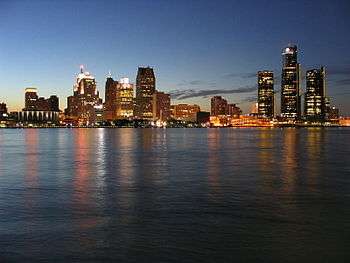 Detroit | |
| Country |
|
| Population | 59,144,461 |
The Great Lakes Megalopolis consists of the group of North American metropolitan areas which surround the Great Lakes region and Saint Lawrence Seaway. It lies mainly within the Midwestern United States, but extends into western Pennsylvania and Upstate New York , as well as Southern Ontario and southern part of Quebec areas in Canada. It is the largest and most populated megalopolis in North America.
The region cuts a wide swath from the Twin Cities in Minnesota to Pittsburgh PA and Rochester NY. On the Canadian side, it extends as far east as Quebec City. Further south, the region is commonly considered to include Kansas City MO, Cincinnati OH, Indianapolis IN, Louisville KY, and Columbus OH. The region had an estimated population of 59,144,461 as of 2011. It is projected to reach a population of approximately 65 million by 2025.
There is substantial overlap between the megalopolis and the once-heavily industrial region known as the Rust Belt; however, the megalopolis and the Rust Belt are not entirely coextensive, and some metropolitan areas may be considered part of one region but not the other.
History of the concept

The region was partially outlined as an emergent megalopolis in the 1961 book Megalopolis: The Urbanized Northeastern Seaboard of the United States by French geographer Jean Gottmann. Gottmann envisaged the development of other megalopolies in the U.S.: BosWash, from Boston to Washington, D.C., Chipitts from Chicago to Pittsburgh, and SanSan, from San Francisco to San Diego. In 1965, Herman Kahn speculated about the future of the three megalopoleis in the year 2000,[1] referring to their names as "half-frivolous" and not mentioning Gottman. In the 1960s and 1970s, urban planner and architect Constantinos Doxiadis authored books, studies, and reports including those regarding the growth potential of the Great Lakes Megalopolis.[2] Doxiadis envisioned Detroit as the central urban area in the Great Lakes Megalopolis. According to him, the megalopolis extended "from Milwaukee and Chicago to Detroit, Pittsburgh and Buffalo and into Canada from Windsor to Montreal and Quebec."[2][3]
The Virginia Tech Metropolitan Institute's Beyond Megalopolis, an attempt to update Gottmann's work, outlined a similar "Midwest" megapolitan area as one of ten such areas in the United States (Canada is discussed tangentially).[4] Over 200 million tons of cargo are shipped annually through the Great Lakes.[5][6][7] Half the nation's population growth and two-thirds of its economic growth is expected to occur within the megaregions over the next four decades. The America 2050 project has identified eleven Megaregions of the United States, including the Great Lakes Megalopolis.[8][A] The Canadian part of the region is also referred to as the Quebec City–Windsor Corridor.
Economy
According to the Brookings Institution, if it stood alone as a country, the economy of the Great Lakes region which includes most of the Great Lakes Megalopolis, would be one of the largest economic units on earth (with a $4.5-trillion gross regional product). The Great Lakes contain one-fifth of the world's surface fresh water and have a combined shoreline of 10,210 miles (17,017 km). About 200 million tons of cargo are shipped by way of the Great Lakes each year.[6][9][10]
Tourism is an important economic factor in and around the Great Lakes. The Great Lakes Cruising Coalition supports passenger ship cruises through a joint U.S-Canadian venture to Great Lakes Ports and the Saint Lawrence Seaway.[11][12]
Major surface transportation corridors
The Great Lakes Megalopolis includes the following major inter-urban corridors that are provided with freeway and passenger rail service.
Minneapolis-Chicago
Interstate highway 94 (I-94) and Amtrak rail run roughly parallel from Minneapolis MN to Chicago IL by way of Madison and Milwaukee WI.
Chicago-Rochester
I-90 and Amtrak run in simillar arrangement from Chicago to Rochester NY via South Bend IN, Toledo OH, Cleveland OH, and Buffalo NY. Amtrak also has a passenger rail link from Cleveland to Pittsburgh PA which is roughly paralleled by I-76.
Chicago-Detroit/Port Huron
I-94 and Amtrak extend from Chicago to the west end of the Windsor-Quebec City Corridor by way of Kalamazoo, Ann Arbor, Detroit, and Port Huron MI/Sarnia ON.
Windsor/Sarnia-Quebec City
Key freeways in the Windsor-Quebec City Corridor include highway 401 and highway 417 in Ontario which connect with autoroutes 20 and 40 respectively in Quebec. Passenger rail service is provided in both provinces by Via Rail. Intermediate points include Sarnia, London, Hamilton, Toronto, Ottawa ON, and Montreal QC.
Secondary surface transportation corridors
Several corridors have interstate highways but no comprehensive passenger rail service:
Kansas City-Pittsburgh
I-70 runs from Kansas City MO to near Pittsburgh PA by way of St. Louis MO, Indianapolis IN, and Columbus OH.
Indianapolis-Port Huron
I-69 extends from Indianapolis IN to the west end of the Windsor-Quebec City Corridor. Intermediate points include Fort Wayne IN, Lansing, Flint, and Port Huron MI/Sarnia ON.
Cincinnati-Saginaw
I-75 runs from Saginaw MI to Cincinnati OH by way of Detroit MI and Dayton OH.
Selected population centers
| Rank | Area | State/ Province |
Image | CSA/CMA 2009 population |
Projected[13][14][15] 2025 population |
Projected increase 2009-2025 |
Projected % increase 2009-2025 |
|---|---|---|---|---|---|---|---|
| 1 | Chicago | Illinois Indiana Wisconsin |
 |
9,804,845 | 10,746,109 | 941,264 | 9.6 |
| 2 | Toronto | Ontario | 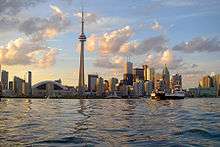 |
5,741,400 | 7,787,000 | 2,045,600 | 35.6 |
| 3 | Detroit | Michigan |  |
5,318,744 | 5,199,608 | -119,136 | -2.2 |
| 4 | Montreal | Quebec |  |
3,859,300 | 4,246,931 | 387,631 | 10.1 |
| 5 | Minneapolis – Saint Paul | Minnesota Wisconsin |
 |
3,604,460 | 4,031,000 | 426,540 | 11.8 |
| 6 | Cleveland – Akron | Ohio |  |
3,515,646 | 3,795,658 | 280,012 | 6.5 |
| 7 | St. Louis | Missouri Illinois |
 |
2,892,874 | 3,049,000 | 156,126 | 5.4 |
| 8 | Pittsburgh | Pennsylvania |  |
2,445,117 | 2,868,818 | 367,299 | 15.0 |
| 9 | Cincinnati | Ohio Kentucky Indiana |
 |
2,214,954 | 2,448,000 | 233,046 | 10.5 |
| 10 | Indianapolis | Indiana | 1,928,982 | 2,270,112 | 341,130 | 16.5 | |
| 11 | Kansas City | Missouri Kansas |
 |
2,038,724 | 2,293,564 | 254,840 | 12.5 |
| 12 | Columbus | Ohio | 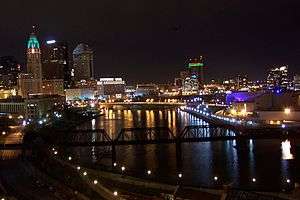 |
2,031,229 | 2,446,450 | 415,221 | 20.4 |
| 13 | Milwaukee | Wisconsin | 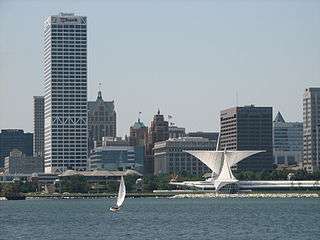 |
2,025,898 | 2,129,949 | 103,706 | 5.1 |
| 14 | Ottawa – Gatineau | Ontario Quebec |
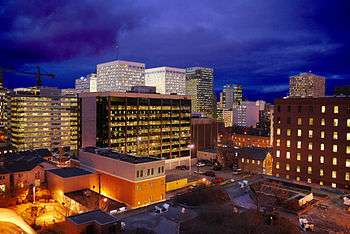 |
1,451,415 | 1,596,556 | 145,141 | 10.0 |
| 15 | Louisville | Kentucky Indiana |
 |
1,395,634 | 1,602,456 | 206,822 | 14.8 |
| 16 | Grand Rapids | Michigan |  |
1,327,366 | 1,530,000 | 202,634 | 15.3 |
| 17 | Buffalo | New York |  |
1,203,493 | 1,040,400 | -163,093 | -13.5 |
| 18 | Rochester | New York |  |
1,149,653 | 1,078,600 | -71,053 | -6.2 |
| 19 | Dayton | Ohio |  |
1,066,261 | 1,066,261 | 0 | 0 |
| 20 | Hamilton | Ontario | 740,200 | 954,858 | 214,658 | 29.1 | |
| 21 | Toledo | Ohio Michigan |
|
672,220 | 672,220 | 0 | 0 |
| 22 | Madison | Wisconsin |  |
628,947 | 820,483 | 191,563 | 30.5 |
| 23 | Youngstown-Warren-Boardman | Ohio Pennsylvania |
 |
602,964 | N/A | N/A | N/A |
| 24 | South Bend-Mishawaka-Elkhart | Indiana Michigan |
564,943 | NA | NA | NA | |
| 25 | Lansing | Michigan | 523,609 | 547,325 | 23,716 | 4.6 | |
| 26 | Kitchener – Waterloo | Ontario | 492,400 | 635,196 | 142,796 | 29.1 | |
| 27 | London | Ontario |  |
492,200 | 634,938 | 142,738 | 29.1 |
| 28 | Rockford | Illinois | 455,595 | 499,400 | 43,805 | 9.9 | |
| 29 | Fort Wayne | Indiana |  |
414,315 | 455,623 | 39,366 | 9.9 |
| 30 | St. Catharines – Niagara | Ontario | 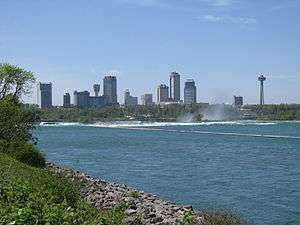 |
404,400 | 521,676 | 117,276 | 29.0 |
| 31 | Davenport-Rock Island-Moline | Iowa Illinois |
 |
379,690 | 452,565 | 72,875 | 26.1 |
| 32 | Fox Cities | Wisconsin | 360,000 | NA | NA | NA | |
| 33 | Oshawa | Ontario | 356,177 | 419,067 | 62,890 | 17.7 | |
| 34 | Windsor | Ontario | 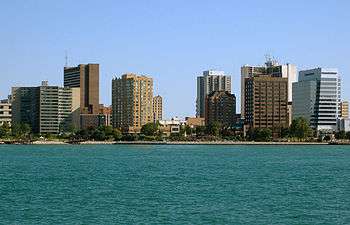 |
330,900 | 426,861 | 95,961 | 29 |
| 35 | Green Bay | Wisconsin | 304,783 | NA | NA | NA | |
| 36 | Erie | Pennsylvania |  |
280,985 | N/A | N/A | N/A |
| 37 | Duluth-Superior | Minnesota Wisconsin |
 |
279,771 | N/A | N/A | N/A |
| Total CSA/CMA of major metro areas |  |
59,781,623 | 65,735,336 | 6,234,698 | 10.0 |
See also
- Combined Statistical Area
- Census Metropolitan Area
- Conurbation
- Great Lakes
- Megalopolis (city type)
- Megaregions of the United States
- Quebec City – Windsor Corridor
Notes
- A. ^ a Various sources include Quebec City, Montreal and Ottawa in the Great Lakes Megalopolis, while excluding Minneapolis–Saint Paul, Kansas City, Cincinnati, Indianapolis, Louisville, and Columbus.[16] All these partial-consensus and non-consensus cities lie at the eastern, western, and southern fringes of the megalopolis.
Gallery
-

Saint Paul
-
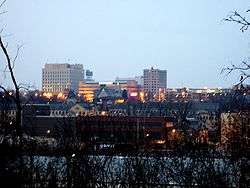
Fox Cities
-

Duluth
References
- ↑ Bell, Daniel; Stephen Richards Graubard (1997). Toward the year 2000: work in progress. MIT Press. p. 87. ISBN 0-262-52237-3.
- 1 2 Cities: Capital for the New Megalopolis.Time magazine, November 4, 1966. Retrieved on July 16, 2010.
- ↑ Doxiadis, Constantinos. (1970) The Great Lakes Megalopolis. Doxiadis Assoc.
- ↑ MegaCensusReport.indd
- ↑ "About Our Great Lakes -Great Lakes Basin Facts- NOAA Great Lakes Environmental Research Lab (GLERL)". Glerl.noaa.gov. Retrieved 2012-04-19.
- 1 2 "Economy of the Great Lakes Region". Great-lakes.net. 2012-04-13. Retrieved 2012-04-19.
- ↑ U.S Army Corps of Engineers (January 2009).Great Lakes Navigation System: Economic Strength to the Nation. Retrieved on April 11, 2011.
- ↑ America 2050: Megaregions: Great Lakes. Regional Plan Association.
- ↑ Our lakes facts. NOAA. Retrieved July 25, 2011.
- ↑ U.S Army Corps of Engineers (January 2009).Great Lakes Navigation System: Economic Strength to the Nation. Retrieved on July 25, 2011.
- ↑ Great Lakes Cruising Coalition Retrieved on July 25, 2011.
- ↑ http://knowledge.wharton.upenn.edu/papers/1319.pdf
- ↑ Federation for American Immigration Reform
- ↑ Ontario Population Projections Update
- ↑ Institut de la statistique Quebec
- ↑ Example: Great Lakes Megalopolis (PDF) (Map). The Center for Urban and Regional Studies, Youngstown State University. 2005.
| ||||||||||||||||||||||||||||||||
Coordinates: 41°N 85°W / 41°N 85°W
